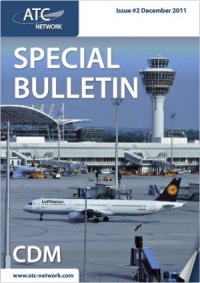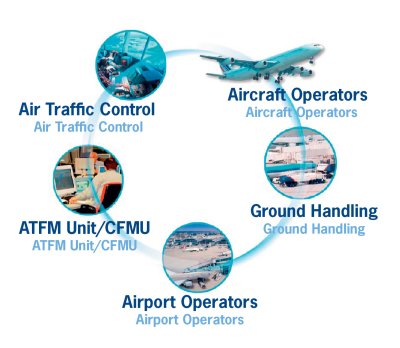
This article originally appeared in the ATC Network Special Bulletin'CDM' - December 2011. To read the complete publication go to:
http://www.atc-network.com/cdm
DFS
http://www.atc-network.com/cdm
DFS
It takes more than just introducing modern systems and updating the infrastructure to achieve more efficient air traffic management and airport processes. This year, Frankfurt Airport was the second German airport to introduce a highly coordinated process called Airport Collaborative Decision Making (A-CDM). Frankfurt aims to continue Munich's success story, a collaborative accomplishment between Munich Airport (Flughafen München GmbH) and the German air navigation service provider, DFS Deutsche Flugsicherung, who launched the A-CDM project in 2004. Both parties have seen a steady improvement in operational efficiency since the implementation of the process. Now they are providing their expertise to other airports, ANSPs and airlines, who are also looking to improve efficiency.
.jpg)
The approach to Collaborative Decision Making by Munich Airport and DFS is based on the European Airport CDM by Eurocontrol, the European Organisation for the Safety of Air Navigation. It was put into operation at Munich Airport in 2007, making it the first A-CDM of this kind implemented in Europe and bringing more than 20 percent reduction in remaining times between off-block and take-off and with that lower emissions. The findings and practical experience gained have considerably influenced developments at the European level.
A-CDM in Munich is based on the existing confirmed off-block procedure and the Target Start-up Approval Time issued by the air traffic controllers, taking into account the Departure Planning Information. Thus, inbound and outbound information is improved and a pre-departure sequence is provided. The coherent process spans flight planning and landing to the subsequent turn-round process on the ground before the next take-off. It helps to fully use all available capacities and operational resources. By using more accurate taxi times and sharing data, all parties involved in the process can optimise the sequence of flights.
Everyone is involved, everyone benefits
Costs can be reduced, emissions can be lowered, punctuality improved and stronger partnerships can be forged. In this way, aircraft can be served according to the "best planned best served" principle. A study on Munich A-CDM has demonstrated that the majority of flights are now ready for take-off at the runway when their slot window starts in other words, five minutes prior to their calculated take-off time. 94 percent of flights now meet their ATFM slots. A Eurocontrol Simulation assessing the impact of A-CDM based on Munich's experience showed that sector capacity within the ECAC core area could be increased by up to two percent, if the major forty airports in Europe implemented Airport CDM and delivered the same quality of information as Munich A-CDM into the European ATM network.
The A-CDM process is based on optimal information-sharing with all partners involved. Everyone benefits airlines, airport operators, air traffic control, air traffic flow management and ground handlers. In short, the air transport network as a whole. In order to achieve understanding and collaboration with all partners, communication and regular working group meetings are necessary.
 Process-related information-sharing is not only achieved by combining data from all partners involved but also by linking existing infrastructures into networks. However, it is not necessary to introduce completely new systems or procedures. It suffices to improve existing ones or add specific components as needed. Erik Sinz of DFS summarises: Airport CDM is a process. Sure, you have the IT systems but first, you need to know what to do with it.
Process-related information-sharing is not only achieved by combining data from all partners involved but also by linking existing infrastructures into networks. However, it is not necessary to introduce completely new systems or procedures. It suffices to improve existing ones or add specific components as needed. Erik Sinz of DFS summarises: Airport CDM is a process. Sure, you have the IT systems but first, you need to know what to do with it. Getting to know the process worldwide
Munich Airport and DFS support other organisations and their partners around the world in implementing a Collaborative Decision Making process at their airports. For instance, DFS has just started projects to develop the concept for airports in the Middle East a region which could benefit greatly from the process due to the expected growth in air traffic. A four-phase model provides the necessary steps for implementing an A-CDM starting with an introductory workshop and finishing with a detailed action plan and the final implementation.
Further information:
Munich Airport / DFS
www.munich-airport.de/cdm, www.worldwide.dfs.eu



.jpg)



.png)

